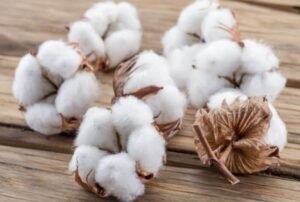With a variety of options for the fabric to choose from, one is bound to get confused in choosing the right fabric. In the modern era, we live in a time where styles change rapidly. Sometimes the comfort is compromised.
We believe you dont want that but want comfort with style. Then you might need to look out for the material that is used to make the clothing. There are natural ones and there are synthetic ones. If you prefer the natural one then we recommend cotton and wool.
Both the materials are natural fiber and are great for your skin and for your body as well. You might wonder which one to choose. To help you with that we are going to talk about the difference and the pros and cons of using those fibers.
What is Wool?
Wool is a protein fiber that is obtained from animals. Commonly wool is obtained from sheep but sometimes it can also be obtained from other species like goats, rabbits, camels, llamas, and many more.

The wool produced on the body of the sheep is sheared every year. The shearing process is beneficial for the sheep to have a healthy coat and prepares for the warmer season. The sheared wool is then cleaned using mild detergent and water to remove any dirt and the greasy material called lanolin.
The cleaned and tried wool fibers are then carded to align the fiber parallel and prepare for spinning. The wool is also dyed for making colorful fabric.
What is Cotton?
Cotton is a natural cellulosic fiber that is obtained from plants. White soft fluffy fibers are harvested from the cotton plant. It is one of the most cultivated non-food crops on earth taking up to 50% of the total textile products.

The cotton is first separated from the seed by ginning method. In this method, dirt is also removed from the cotton. The cleaned cotton is then carded and combed to remove any short pieces and the left-out impurities. The cotton is then turned into yarn which is later made into fabrics by knitting or weaving method. The cotton is dyed using different methods like yarn dyeing, fabric dyeing, etc.
Key Differences between Wool and Cotton
Both fiber cotton and wool are natural materials with high performance. These have been widely used all over the world for a long time and are still quite famous in the textile industry. Despite having similarities in the qualities there are sure to have a few differences. Since both of them are different materials.
Here are the few differences we can find between wool and cotton.
Source of materials
As already mentioned above, wool is obtained from animals like sheep, rabbits, goats, etc. Wool is a protein fiber that gets produced in the body of the animals providing a protective layer. The types of wool can be different depending on the If not sheared then the wool would create a problem for the animals, especially sheep.
Cotton is harvested from a cotton plant. The fluffy part surrounds the seed of the plant which is later seperated. Cotton harvesting usually starts around the month of July which may extend to the month of November.
Breathability
Both the materials wool and cotton are breathable materials. But the capability of breathability is quite different in both.
Wool is much more breathable compared to cotton. The fiber of the wool absorbs around 30% of moisture and keeps the surface dry. The wool does not absorb the moisture immediately but takes more time compared to cotton which makes it feel breathable even in damp conditions. Due to this many sportswear and outdoor outfit producing companies are developing clothing from wool.
Cotton does have breathable features but has less compared to wool in damp weather. It is less absorbent and has a less moisture-wicking ability. This also prevents the moisture from evaporating and keeps you feeling wet for a long time. This makes the materials less breathable.
Durability
Compare to many other fibers like semi-synthetic or synthetic fiber, cotton and wool are much more durable. But when it comes to wool and cotton then will is much more durable.
The fact that cotton can be bent up to 3,000 times before it breaks whereas wool can be bent 20,000 times before it can be bent makes it more durable. Wool is quite springy compare to cotton meaning that wool can easily retains its shape even when going through rough treatment.
The moisture repelling quality of the wool prevents the fibers from getting weak from the liquid as well. So, with proper care, products made from wool can last you for a long period of time compared to cotton.
Warmth
Wool is significantly known for providing warmth in the winter season. It can hold heat better than cotton. The tiny spaces in the wool fiber capture the heat radiated from your body which keeps you warm. Wool fiber is also thicker than cotton. It can keep you warm even when the weather is windy and rainy.
Cotton also does have such spaces but they are mostly occupied by water. This is why it is mostly preferred in the warmer season. It keeps your body cool in the warm weather.
So, for the warmth wool is better at getting the job done whereas cotton is best for keeping yourself cool.
Cost of Materials
Wool is on the more expensive side than cotton due to various reasons. The cost of production and the availability of the products greatly affect the price of the materials.
Wools can be sheared once a year for every sheep. So, shearing the sheep requires skill, and only a few people are trained to do so. Likewise, after the wool is sheared it requires a different treatment and process for the wool to be used as a fabric.
Cotton can be easily harvested and it can be grown nearly all over the year. Resources required for growing and processing cotton are also less compared to wool. It can be grown in fewer areas as well.
These factors affect the price of the materials. This makes wool much more expensive. If you are to keep the durability of the wool then the price of wool makes up for the amount of money spend on buying a few cotton clothes which wear and tear in a short time.
Texture
In terms of smoothness or softness, cotton takes the lead. This is all related to the scale of the fiber. The scales of the wool is overlapped with each other to form the thread. The scales act like a hook that gets caught on to the skin and hair. Some wool can be smoothened and softened using different treatments and chemicals.
Cotton is naturally smooth and soft. The cellulose fiber makes the cotton naturally smother which gets softer with frequent washing. This provides a soft feel to your skin compared to wool.
Care and Maintenance
Both the materials do not require extreme care and maintenance. You can easily hand wash or machine wash them. Cotton is easier to care to compare to wool fabric.
We all are aware that wool can shrink easily if exposed to heat or can be felt if extreme motion happens when wet. So, when cleaning the wool we should not use extremely hot water but rather use cold water to mild temperature water. No harsh chemical should be used when cleaning the wool products.
Don’t worry about damaging your wool products with frequent washing as wool does not require frequent washing due to its self-cleaning properties.
Cotton materials require less maintenance compared to wool. You don’t have to worry about damaging the fabric by washing it frequently. You can increase the life span of both fabrics by avoiding excessive exposure to the sun and heat.
Uses of the fabric
Wool and cotton are both widely used in the industry to make different things. In terms of comparison to the uses cotton has quite more uses whereas the wool material is quite limited.
Wool garments are mostly combined with clothes or items suitable for the cold season whereas cotton is more related to clothes suitable for the warm season. Wool materials are included as a base layer for socks, hats, gloves, scarves, and mid-layer for skirts, dresses, cardigans, and sweaters.
Cotton materials are used to make lightweight clothing and garments that are suitable for the warm weather like T-shirts, socks, pajamas, and denim. Sometimes it’s also combined with jackets and sweaters to provide extra warmth in the winter season. Cotton can also easily blend with other fabrics like polyester and spandex.
Which is Better, Wool or Cotton?
Asking which fabric is better is like asking “Which is better, fork or spoon?”. Depending on the situation, sometimes one can be better than the other. We can say the same for wool and cotton. So there is no clear answer to that question.
Like wool is great for the colder season, providing great warmth and coziness. The thick material of the wool prevents the heat from passing through which keeps the body warm. Wool also has moisture-absorbing properties which can absorb your sweat and prevents any bacteria buildup as well. So, wool can be a great material to be worn if you sweat.
During the warm season, cotton is an excellent material to be worn. It won’t irritate your skin and lets the air pass easily to provide coolness to your body. Cotton can be combined with other fabrics like wool to add extra warmth as well.
Wool is quite more expensive than cotton but the durability makes it worth the price. It will last you a long time. Cotton garments can also last you for a long time with proper washing and care.
